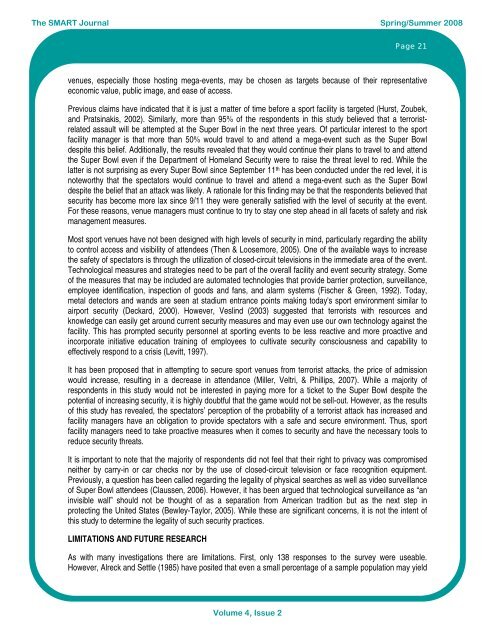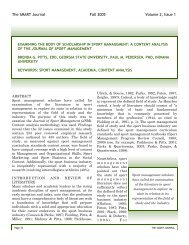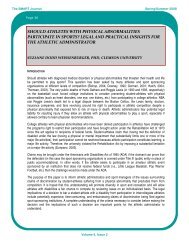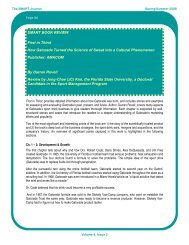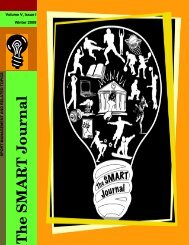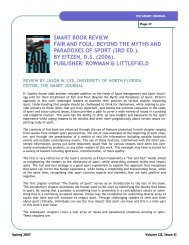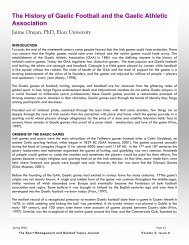Spring/Summer 2008 Volume 4, Issue 2 - The SMART Journal
Spring/Summer 2008 Volume 4, Issue 2 - The SMART Journal
Spring/Summer 2008 Volume 4, Issue 2 - The SMART Journal
Create successful ePaper yourself
Turn your PDF publications into a flip-book with our unique Google optimized e-Paper software.
<strong>The</strong> <strong>SMART</strong> <strong>Journal</strong> <strong>Spring</strong>/<strong>Summer</strong> <strong>2008</strong><br />
Page 21<br />
venues, especially those hosting mega-events, may be chosen as targets because of their representative<br />
economic value, public image, and ease of access.<br />
Previous claims have indicated that it is just a matter of time before a sport facility is targeted (Hurst, Zoubek,<br />
and Pratsinakis, 2002). Similarly, more than 95% of the respondents in this study believed that a terroristrelated<br />
assault will be attempted at the Super Bowl in the next three years. Of particular interest to the sport<br />
facility manager is that more than 50% would travel to and attend a mega-event such as the Super Bowl<br />
despite this belief. Additionally, the results revealed that they would continue their plans to travel to and attend<br />
the Super Bowl even if the Department of Homeland Security were to raise the threat level to red. While the<br />
latter is not surprising as every Super Bowl since September 11 th has been conducted under the red level, it is<br />
noteworthy that the spectators would continue to travel and attend a mega-event such as the Super Bowl<br />
despite the belief that an attack was likely. A rationale for this finding may be that the respondents believed that<br />
security has become more lax since 9/11 they were generally satisfied with the level of security at the event.<br />
For these reasons, venue managers must continue to try to stay one step ahead in all facets of safety and risk<br />
management measures.<br />
Most sport venues have not been designed with high levels of security in mind, particularly regarding the ability<br />
to control access and visibility of attendees (<strong>The</strong>n & Loosemore, 2005). One of the available ways to increase<br />
the safety of spectators is through the utilization of closed-circuit televisions in the immediate area of the event.<br />
Technological measures and strategies need to be part of the overall facility and event security strategy. Some<br />
of the measures that may be included are automated technologies that provide barrier protection, surveillance,<br />
employee identification, inspection of goods and fans, and alarm systems (Fischer & Green, 1992). Today,<br />
metal detectors and wands are seen at stadium entrance points making today's sport environment similar to<br />
airport security (Deckard, 2000). However, Veslind (2003) suggested that terrorists with resources and<br />
knowledge can easily get around current security measures and may even use our own technology against the<br />
facility. This has prompted security personnel at sporting events to be less reactive and more proactive and<br />
incorporate initiative education training of employees to cultivate security consciousness and capability to<br />
effectively respond to a crisis (Levitt, 1997).<br />
It has been proposed that in attempting to secure sport venues from terrorist attacks, the price of admission<br />
would increase, resulting in a decrease in attendance (Miller, Veltri, & Phillips, 2007). While a majority of<br />
respondents in this study would not be interested in paying more for a ticket to the Super Bowl despite the<br />
potential of increasing security, it is highly doubtful that the game would not be sell-out. However, as the results<br />
of this study has revealed, the spectators’ perception of the probability of a terrorist attack has increased and<br />
facility managers have an obligation to provide spectators with a safe and secure environment. Thus, sport<br />
facility managers need to take proactive measures when it comes to security and have the necessary tools to<br />
reduce security threats.<br />
It is important to note that the majority of respondents did not feel that their right to privacy was compromised<br />
neither by carry-in or car checks nor by the use of closed-circuit television or face recognition equipment.<br />
Previously, a question has been called regarding the legality of physical searches as well as video surveillance<br />
of Super Bowl attendees (Claussen, 2006). However, it has been argued that technological surveillance as “an<br />
invisible wall” should not be thought of as a separation from American tradition but as the next step in<br />
protecting the United States (Bewley-Taylor, 2005). While these are significant concerns, it is not the intent of<br />
this study to determine the legality of such security practices.<br />
LIMITATIONS AND FUTURE RESEARCH<br />
As with many investigations there are limitations. First, only 138 responses to the survey were useable.<br />
However, Alreck and Settle (1985) have posited that even a small percentage of a sample population may yield<br />
<strong>Volume</strong> 4, <strong>Issue</strong> 2


